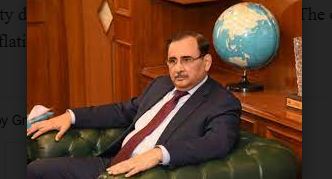Mian Anjum Nisar says enhancement in exports requires wide structural reforms

ISLAMABAD: /DNA/ – The high gas and power prices have made the local as well as the export industry uncompetitive on the world market resulting in an 8 per cent monthly and 7 percent annual decline to $1.3 billion in November.
The BMP Chairman and FPCCI former president Mian Anjum Nisar observed that the government would have to sustain its top focus on enhancing the share of renewable energy and hydropower projects to lower energy costs through an improved energy mix, although financing for such projects remained a key challenge. He said that enhancing the share of renewable energy (RE) and hydropower in the energy mix was the government’s priority and needed to be sustained over a longer horizon as it was the only way to provide affordable energy to the people.
Quoting the figures, he said that in rupee terms, the country’s textile exports clocked in at Rs376bn, down by 7pc month-on-month but rose 19pc year-on-year owing to rupee depreciation against the dollar. Basic textiles witnessed a fall of 14pc MoM and a rise of 20pc YoY to $243m in November. The YoY substantial increase resulted from the 12 times YoY increase in raw cotton exports due to the significant growth in cotton crop this year as compared to last year, which was greatly affected by floods.
Value-added textile exports reached $920m, up by 6pc MoM while it fell by 12pc YoY. Towels remained the major contributor to the segment with 21pc MoM and 20pc YoY drop in exports. Knitwear saw a 5pc MoM and a 12pc YoY decline.
Bedwear posted a 16pc MoM and 8pc YoY fall followed by 12pc YoY decline in readymade garments but a 5pc MoM rise.
In 5MFY24, textile exports shrank by 6pc to $6.9bn from $7.4bn in the same period last year due to an economic slowdown and a reduced demand for textile products worldwide.
The government has set a textile export target of $25bn. However, textile exports for FY24 will reach $17bn, up 3pc YoY.
Pakistan’s Information Technology (IT) exports rose nine per cent month-on-month to $259 million in November, which was also higher than the 12-month average of $222m.
The jump is due to a relaxation in the permissible retention limit by the State Bank of Pakistan (SBP), increasing it from 35pc to 50pc in the Exporters’ Specialised Foreign Currency Accounts, and the stable rupee which encourages IT companies to repatriate their foreign income and deposit it in local accounts.
IT export number indicates the amount remitted back to Pakistan by technology companies.
FPCCI former president and Businessmen Panel (BMP) Chairman said that the drop shows the government would find it difficult to achieve the industrial growth and export target, leading to more pressure on foreign exchange reserves of the country. He asked the government to address the underlying structural vulnerabilities through smooth energy supply at competitive rates, as country’s overall export proceeds continued to shrink for the fifth consecutive month in a row.
Quoting the data, he pointed out 1.7 billion dollars decline in remittances during the first half of the current year compared to the same period the year before (a decline of 11.1 percent), exports declined by 6.6 billion dollars (6.8 percent decline), foreign direct investment dipped by 654 million dollars (58 percent decline), portfolio investment plummeted from negative 45.5 to negative 1032 million dollars, Public Sector Development Program decreased by 122 billion rupees (48.4 percent) and credit to private sector from 1043.1 to 703.6 million rupees which contributed to a decline in Nov 2021 Large Scale Manufacturing Sector growth of 6 percent to negative 5.50 percent in the comparable period this year.
Rising prices of wheat are the key factors responsible for affecting the general price level. International commodity prices are showing downward trend on a YoY basis and its impact will ultimately be transmitted into domestic prices with some lags after adjusting the currency devaluation. While the government kept the administered prices at their current level to stabilize the overall prices but post floods persistent shortfall of essential crops is preventing inflation to settle down.
He observed that the drop in textile and clothing exports is gaining momentum over the past five months owing to multiple factors including high energy costs, stuck-up refunds and a slump in global demands despite the massive depreciation of the rupee. He believes that one of the main reasons behind falling exports was the exchange rate instability. The discontinuation of duty drawbacks on local taxes and levies by the government has also created liquidity issues for the export sector.
Mian Anjum Nisar said that the government has increased the gas and electricity tariffs and, at the same time, also the subsidy has been phased out, which will further increase the cost of production.
Month on month increases in consumer prices may be countered by a further mean reverting international commodity prices and some exchange rate stability due to decreased pace of depreciation. The overall money supply growth remains compatible with a return to low and stable inflation.
Related News

PIAF urges government action as short-term inflation pressure continues
LAHORE, DEC 28 /DNA/ — The Pakistan Industrial & Traders Association Front (PIAF) has calledRead More

RCCI hosts Ambassador Oumer Oba for business talks
RAWALPINDI, DEC 24 /DNA/ – Oumer Hussein Oba, Ambassador-designate of the Federal Democratic Republic ofRead More


Comments are Closed